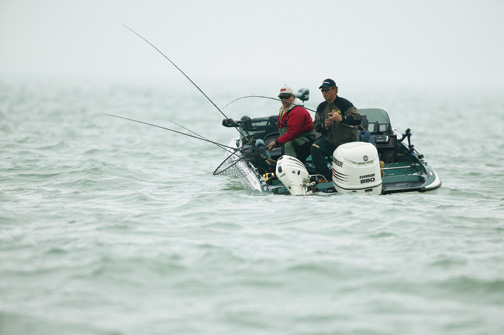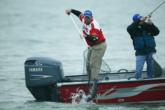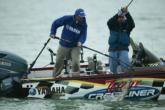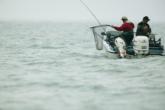Big-water walleyes
Learn to divide, conquer vast bodies of water into manageable segments

Check out a map, stand on shore or simply imagine, if you will, the vast waters where the Wal-Mart RCL Walleye Tour holds most of its events, and the wide-open spaces are bound to give pause to the uninitiated. A Missouri River reservoir in the Dakotas stretches between dozens and hundreds of miles from one dam to the next. Lake Erie, a favorite Great Lakes tournament venue, unfurls toward four states and even across the border to another nation. It would be easy to get lost in the abundance of water and walleyes.
Lund pro Bob Crow of Paterson, Wash., was indeed dazed and a tad bit confused when faced with the prospect of water, water everywhere during his formative years in tournament fishing.
“My first time on Erie, I looked at a map and said, `Oh, man, I’m done,'” Crow said. “I don’t get worried anymore. I’ll go three or four days without catching a fish to eliminate water. Then I concentrate on catching fish.”
 Crow’s strategy of eliminating unproductive water without panicking is a hallmark of successful tournament angling. It is a trait he shares with other notable performers who divide and conquer – which is to say, they all split the water into more manageable segments depending on seasons and then figure out not only the most efficient way to catch the biggest fish in the system, but also how to steer clear of the tournament scuttlebutt of who is catching what and where.
Crow’s strategy of eliminating unproductive water without panicking is a hallmark of successful tournament angling. It is a trait he shares with other notable performers who divide and conquer – which is to say, they all split the water into more manageable segments depending on seasons and then figure out not only the most efficient way to catch the biggest fish in the system, but also how to steer clear of the tournament scuttlebutt of who is catching what and where.
“In a lot of cases, successful tournament fishing is a matter of first finding the concentration of winning fish and then refining the presentation itself,” said Mark Dorn, director of walleye operations for FLW Outdoors. “These guys have developed a talent over the years to sort through the fluff and hype to find what it’s going to take to win the tournament.”
Winning an event or, at the very least, finishing in the money, is no simple task when confronted with a Missouri River reservoir that is four times the length of Rhode Island. The way they do it is by considering the parts of the sum instead of the other way around.
On the res.
At first glance, the RCL Tour sites on the Missouri River are undoubtedly daunting. Lake Sharpe, site of last year’s qualifying event out of Pierre, S.D., unfolds 80 miles south to the next dam, Big Bend, near Fort Thompson, with 200 miles of serpentine shoreline. On the 2004 schedule is Lake Oahe, the reservoir upstream of Pierre, where the numbers are daunting and require little embellishment: 231 miles long, 2,250 miles of shoreline.
 Perish the thought? Not when you take direction from Crestliner pro Rick Olson of Mina Lake, S.D., a reservoir master with decades of experience on Oahe. Olson’s M.O. is to split a reservoir into thirds and focus on a section according to time of year. In May and June, Olson concentrates on the upper third of the reservoir; June through August on the middle third; and August and September on the lower third.
Perish the thought? Not when you take direction from Crestliner pro Rick Olson of Mina Lake, S.D., a reservoir master with decades of experience on Oahe. Olson’s M.O. is to split a reservoir into thirds and focus on a section according to time of year. In May and June, Olson concentrates on the upper third of the reservoir; June through August on the middle third; and August and September on the lower third.
“My theory in reservoirs is that schools run in groups,” Olson said. “The school isn’t running together, but it’s using one section of the reservoir.”
Where precisely the walleyes are in their stage of dispersal after the spring spawn depends on weather, but Olson’s principle of thirds at least starts to cut a place like Oahe down to size. Next, Olson considers seasonal trends and the governing principle behind all reservoirs – the river channel.
For instance, in summertime on a reservoir, Olson finds that walleyes with normally notorious wanderlust tend to stay put on flats, with a big school occupying a stretch of a few miles.
“Reservoir fish are constantly moving, but I’ve seen where they’ve spent a couple of months on a large flat a mile or two long in the heart of summer,” Olson said. “And I’m always aware of where the river is to see if that’s where the fish are.”
The river channel, you see, is the source of the reservoir itself, the river pent up by the dam, and it provides a pathway for the fish to travel and a place for repose.
“If the river channel goes next to the bank, that’s where you want to fish it,” said Lund pro Todd Frank of Pulaski, N.Y., a Great Lakes expert who always seems to place well in reservoir tourneys.
Look on a map to find the river channel to see where it swings next to points and bluffs, but it is also possible to follow the channel with electronics, watching for the deep trough to see which banks and ledges the channel abuts. Even later in the summer, when walleyes tend to move off banks for the middle of the reservoir and deeper water, the channel provides a focal point for techniques such as bottom bouncing or crankbait trolling. If the channel, for instance, is as deep as 80 feet in Oahe, summertime fish are apt to suspend above it rather than to roam the nearby banks without the channel’s presence and governing influence.
“Reservoir walleyes follow the same principle of channel orientation whether they’re on the points and banks or in the middle of the reservoir,” said Ron Gazvoda, a Ranger pro living in Lakewood, Colo.
And so a reservoir starts shrinking to more manageable dimensions with Olson’s rule of thirds and the overarching philosophy of the channel making the walleye’s world go around. Don’t leave the dock without them.
Crow uses a proven twin-pronged approach for the expansive waters of the Great Lakes, last year’s site of an RCL Tour qualifying event in late May. With tournament headquarters again in Port Clinton, Ohio, the RCL Tour arrived a month earlier this year, and the same task of slicing water down to size applied. For Crow, that meant first finding structure-oriented fish, as it is called in angling parlance, and then searching for bigger ones suspended out in open water with the help of electronics.
“I start with fish that are staying with some kind of structure because they’re easier to catch,” Crow said. “Then I move out to the middle of nowhere to find the bigger fish. On the Great Lakes, there’s no reason to fish if you don’t see fish. I always move at a decent clip to try to mark fish before I fish them.”
By structure fish, Crow means walleyes hanging around islands, points and contour lines, a trend on Erie and other Great Lakes in recent years. Some onlookers attribute it to clearer water with the advance of sediment-straining zebra mussels. Others attribute it to better electronics, with GPS mapping capabilities that show contour lines now at our disposal. Either way, the fact remains that a portion of Erie walleyes run the shoreline contours around the Bass Islands and the shoreline points east of Port Clinton toward Lorain, Ohio. Beyond the schools in close, though, is the possibility of a lode in open water, where the likes of Crow do not start trolling until they see fish first.
Take it from Frank, who adjusts his liquid-crystal color electronics to give him the optimal readouts at relatively high speed. To do so, he cranks up the sensitivity to the 90-percent range and the ping speed to 100 percent. (Ping speed is the rate at which the sonar’s signal bounces off bottom and returns to the unit to yield its reading.) Now Frank is able to scoot up to 30 mph, with best readings at about 25 mph, to see the red and yellow streaks of walleye schools that would otherwise be indistinguishable in the surface clutter of a black-and-white unit.
If seasonal trends play a role on reservoirs, the same principle applies to Erie. Here, though, walleyes start a counterclockwise circumnavigation of the lake after spawning on the reefs in the Western Basin, poised to return in the fall. What the longstanding migration yields on Erie is a constant pattern of migration to the east, and how far the schools of the biggest fish have progressed depends upon the season – closer to the Bass Islands in the spring, farther east in Ohio toward Pennsylvania later in the year. Weather, of course, plays a critical role, with a late spring impeding the movements and the advance of summer hastening them.
Then, to crack the code of both where the fish are and how to catch them, you had better check a variety of depths to zero in on something more precise. For starters, a little local information never hurts.
“The last thing I ask is what color,” Frank said. “The first thing I ask is how deep. Once I find that first school, I can fine-tune how to catch them and go looking for more.”
For his part, Crow moves quickly and trolls crankbaits just to find a few fish before evaluating whether to switch to spinners with night crawlers, a slower presentation that often makes sense to keep a bait in the walleye’s face longer. But for finding them in the first place, nothing beats cranking.
“I’ll throw cranks out and move, going through my lures, trolling at 2.5 mph,” Crow said. “I try to cover as much water as possible the first two days. You might not catch a lot of fish, but you get rid of water fast.”
An additional strategy for eliminating water is to stagger the running depths of crankbaits or spinners in the water column – say, in the top 5 feet, next at 10 feet, and after that 15 and 20 feet. In a trolling pattern, a variety of depth levels targets high fish that are suspended out of the scope of electronics and keeps offerings above them, since walleyes in clear water often streak up 10 feet or more to take the bait.
So go ahead and study a map, stand on a shore or imagine, if you will, where and how opportunity knocks on reservoirs and the Great Lakes. Of course there is water, water everywhere, but the task of eliminating it and finding the productive stretches is far more possible and practicable when approached in more manageable segments.
